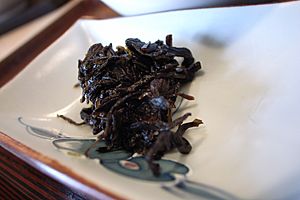Tsukudani facts for kids

Tsukudani (佃煮) is a special Japanese dish. It is made from small pieces of seafood, meat, or seaweed. These ingredients are cooked slowly in a sauce of soy sauce and mirin (a sweet cooking wine).
Tsukudani is very flavorful and salty. This saltiness helps to keep the food fresh for a long time, especially in Japan's humid weather. It was first made on an island called Tsukudajima in the Edo period. This island is now part of Chūō, Tokyo.
Many different kinds of tsukudani are sold today. Because it can be stored for a long time, it has been a popular side dish in Japanese kitchens since the Edo period.
Tsukudani is often made using kombu or wakame seaweeds. Sometimes, it is made from ingredients left over after making dashi (a Japanese soup stock). This helps to reduce waste. Tsukudani has a very strong flavor. People usually eat a small amount, like one tablespoon, with a bowl of steamed rice. When served, tsukudani is chilled from the refrigerator. It then has a soft, jelly-like texture.
Different Kinds of Tsukudani
People in different parts of Japan make tsukudani with various ingredients. Here are some examples:
- Asari no tsukudani (あさりの佃煮): This type is made with small clams. It is popular in Chiba Prefecture.
- Ikanago no kugini (いかなごのくぎ煮): This tsukudani uses small fish called sand lance. You can find it in Hyōgo Prefecture.
- Inago no tsukudani (いなごの佃煮): This unique tsukudani is made from locusts. It is eaten in areas like Fukushima Prefecture and Nagano Prefecture.
- Zazamushi no tsukudani (ざざむしの佃煮): This kind is made from insect larvae, like those of stonefly and caddisfly. It is a local specialty in Ina, Nagano.
See also
 In Spanish: Tsukudani para niños
In Spanish: Tsukudani para niños

